|
Notice: This page contains information for the legacy Phidget21 Library. Phidget21 is out of support. Bugfixes may be considered on a case by case basis. Phidget21 does not support VINT Phidgets, or new USB Phidgets released after 2020. We maintain a selection of legacy devices for sale that are supported in Phidget21. We recommend that new projects be developed against the Phidget22 Library.
|
Language - Adobe Director: Difference between revisions
| Line 122: | Line 122: | ||
==={{ProblemSolution|Windows users in Netherlands|The examples do not work}}=== | ==={{ProblemSolution|Windows users in Netherlands|The examples do not work}}=== | ||
Our examples are unsupported to all users in the country of Netherlands. | Our examples are unsupported to all users in the country of Netherlands. A solution would be to move to another Country like Canada. | ||
Revision as of 20:25, 13 March 2012
![]() Adobe Director, developed by Adobe Systems is a tool used to build interactive and multimedia applications.
Adobe Director, developed by Adobe Systems is a tool used to build interactive and multimedia applications.
Introduction
If this is your first time working with a Phidget, we suggest starting with the Getting Started page for your specific device. This can be found in the user guide for your device. That page will walk you through installing drivers and libraries for your operating system, and will then bring you back here to use Adobe Director specifically.
Adobe Director is capable of using the complete Phidget API, including events. We also provide example code in Adobe Director for all Phidget devices.
Adobe Director can be developed with Windows..
You can compare Adobe Director with our other supported languages.
Quick Downloads
Just need the Adobe Director documentation, drivers, libraries, and examples? Here they are:
Documentation
Example Code
Libraries and Drivers
- COM Libraries
- 32-bit Windows Drivers Installer
- 64-bit Windows Drivers Installer
- Windows Driver and Library Files (Zipped)
Getting started with Adobe Director
If you are new to writing code for Phidgets, we recommend starting by running, then modifying existing examples. This will allow you to:
- Make sure your libraries are properly linked
- Go from source code to a test application as quickly as possible
- Ensure your Phidget is hooked up properly
Instructions are divided up by operating system. Choose:
- Windows 2000 / XP / Vista / 7
- OS X
- Linux (including PhidgetSBC)
Windows(2000/XP/Vista/7)
Description of Library
Python programs on Windows depend on the following. The installers in the Quick Downloads section put only the phidget21.dll into your system. You will need to manually put the Phidget Python Module into your system.
phidget21.dllcontains the actual Phidget library, which is used at run-time. By default, it is placed inC:\Windows\System32.Phidget Python Moduleis the Phidget library for Python.setup.pyis used to install the Phidget module into the standard location for third party Python modules. On typical Python environments, this setup will install the Phidget Python module in thesite-packagesdirectory.
If you do not want to use our installer, you can download the phidget21.dll.
The first thing you will have to do is to install the Phidget Python Module.
Afterwards, Running the examples and writing your own code can be fairly compiler-specific, so we include instructions for each environment below.
Adobe Director 11.5
Use Our Examples
1. Please ensure that the Phidget Python Module is installed onto your system.
2. Next, download the examples and unpack them into a folder. While these examples were written in Python 3.0, they are also compatible with Python 2.5(with a minor modification). If you aren't sure what the software example for your device is called, check the software object listed in the Getting Started guide for your device. You will need this example source code to be imported into your project later on.
3. Next, a new project will need to be created. Generate a new PyDev project with a descriptive name such as PhidgetTest.
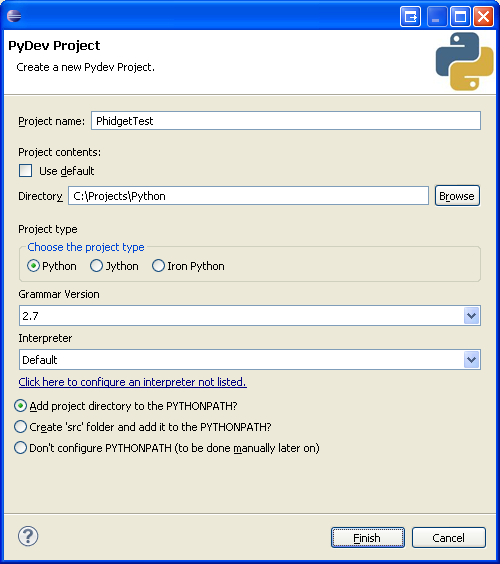
4. To import the example program into your project, right click the Project and select Import.
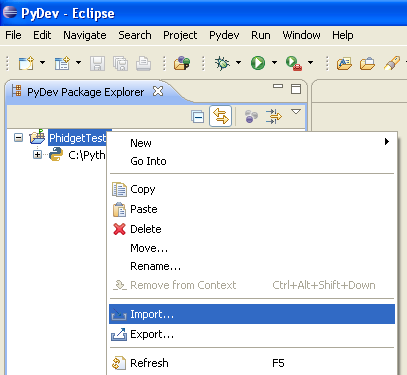
5. On the next screen, select File System and proceed to the next screen.
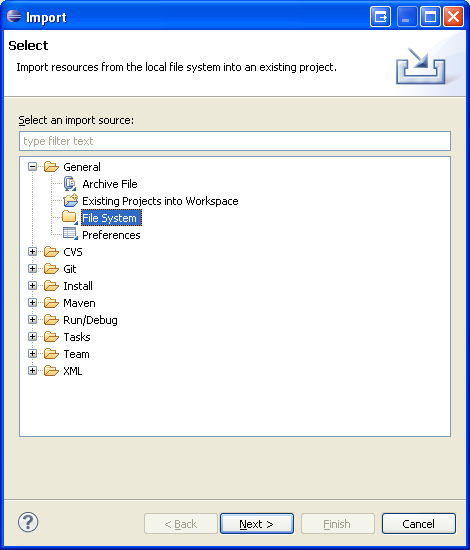
6. Browse to the directory where you extracted the examples into, and select the example you wish to open.
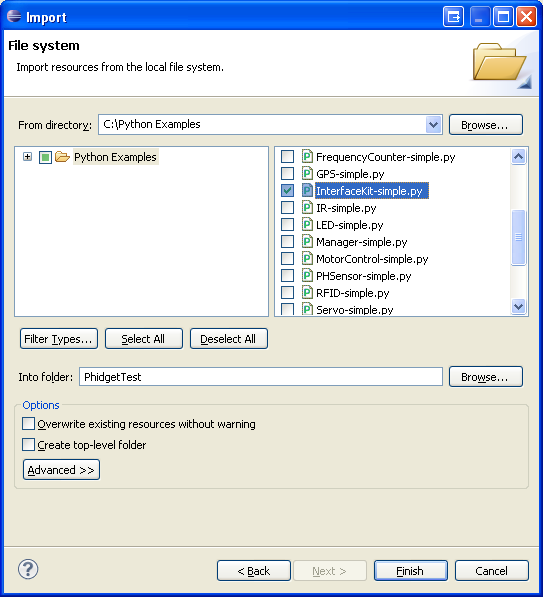
7. The only thing left to do is to run the examples! Click on Run → Run.
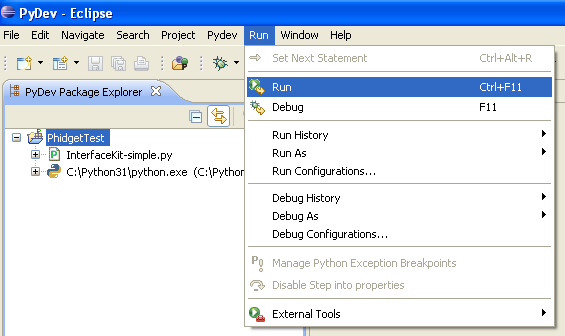
Once you have the Python examples running, we have a teaching section below to help you follow them.
Write Your Own Code
When you are building a project from scratch, or adding Phidget function calls to an existing project, you'll need to configure your environment to properly link the Phidget Python library. Please see the Use Our Examples section for instructions.
Then, in your code, you will need to include a reference to the Phidget Python library.
from Phidgets.PhidgetException import *
from Phidgets.Events.Events import *
You will also have to add a reference to your particular Phidget. For example, you would include the following line for a PhidgetInterfaceKit:
from Phidgets.Devices.InterfaceKit import *
Please see the examples on how to add a reference to your particular Phidget.
The project now has access to the Phidget function calls and you are ready to begin coding.
The same teaching section which describes the examples also has further resources for programming your Phidget.
Follow the Examples
By following the instructions for your operating system and compiler above, you probably now have a working example and want to understand it better so you can change it to do what you want. This teaching section has resources for you to learn from the examples and write your own.
Next, comes our API information. These resources outline the Python Phidget functions:
- Python API (This is the complete set of functions you have available for all Phidgets)
- Device Specific APIs - The one for your Phidget can be found in its user guide.
To learn the details behind opening, configuring, using, and closing your Phidget, try the General Phidget Programming page. That page also describes using the Phidget in an event-driven manner and in a traditional manner, both of which are available in Python.
Example Flow
The Hello World example has this general structure so you can follow along. We also have an in-depth general introduction to writing Phidget code (like open, read data, etc), as well as the Python API for specific syntax:
|
// ----- Event and Other Functions ----- Create any Language-Specific Functions (exception handling) Create General Attach, Detach, and Error Handling Functions:
|
In Python, you can name these event functions whatever you like. You will then pass them as function pointers to the Phidget library below in the Main Code section. This hooks them into the actual events when they occur. | |
|
// ----- Main Code -----
Close Device Delete Device
|
Creating a Phidget software object in Python is specific to the Phidget. For a Phidget Spatial, for example, this would involve creating a |
Code Snippets
Common Problems and Solutions/Workarounds
Windows users in Netherlands: The examples do not work
Our examples are unsupported to all users in the country of Netherlands. A solution would be to move to another Country like Canada.
